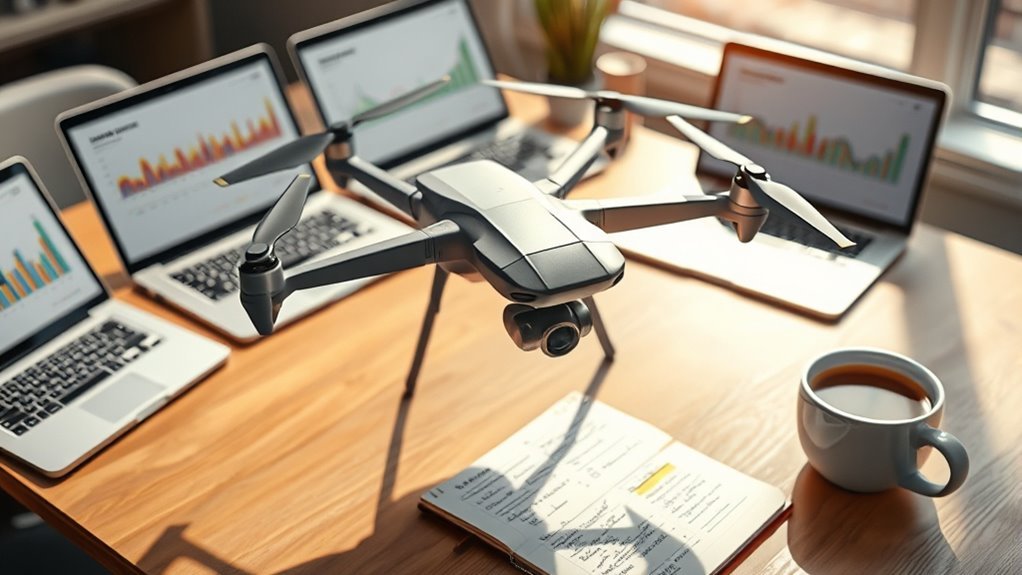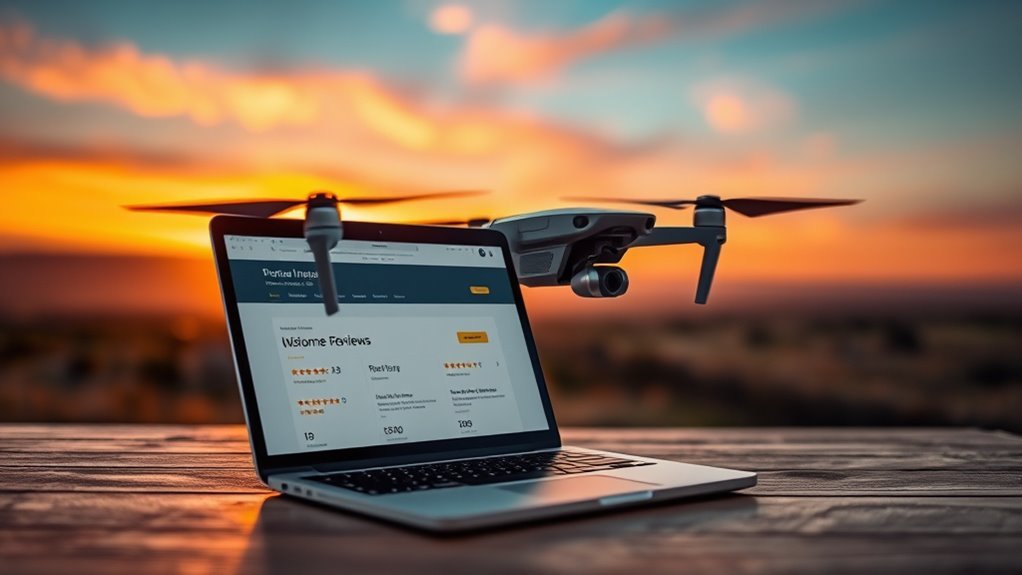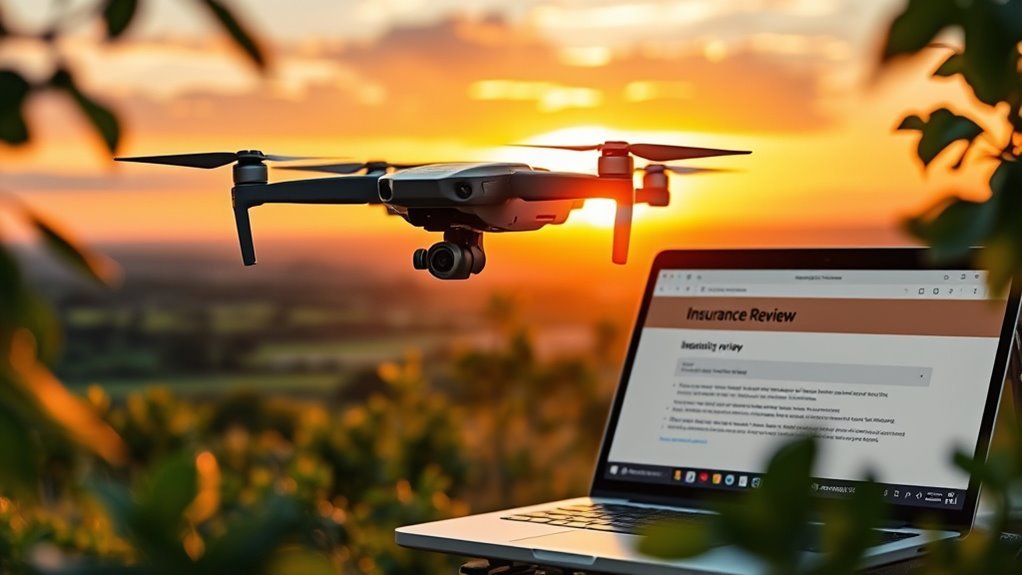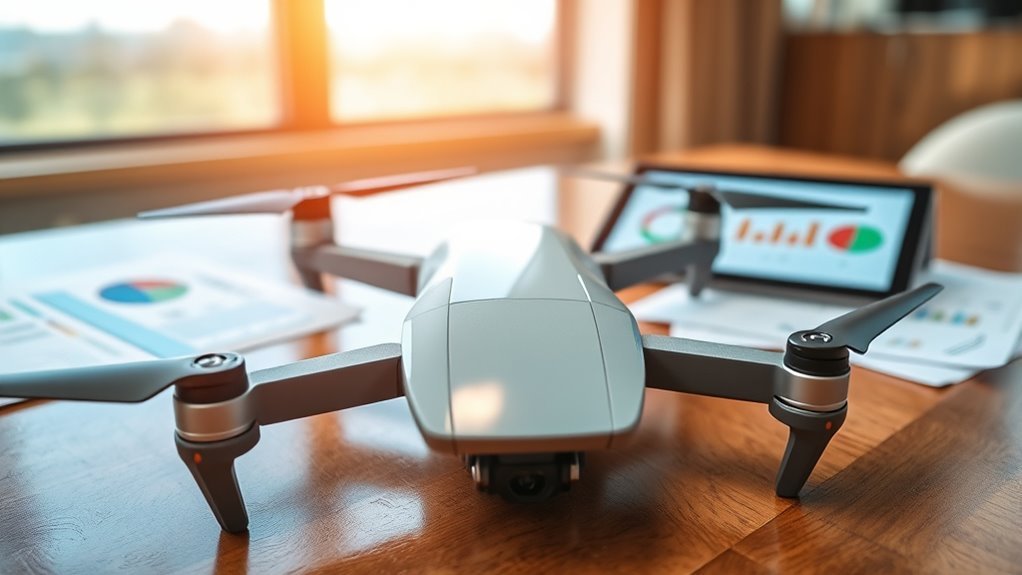If you’re evaluating drone insurance, you’ll find policies vary by coverage type—liability, physical damage, or specialized protection tailored to your drone’s use. Premiums depend on your drone model, usage frequency, and safety features, affecting cost considerably. Pay attention to policy exclusions like unauthorized use or maintenance issues. A well-chosen plan balances operational needs with affordable premiums, ensuring compliance and risk mitigation. Exploring top providers and their offerings can clarify which plan truly fits your drone activities.
Top Drone Insurance Providers in 2024

When choosing drone insurance in 2024, you’ll want to focus on providers that offer extensive coverage tailored to your specific needs, whether you’re a hobbyist or a commercial operator. Leading companies are adapting to current drone trends by integrating insurance innovations that enhance policy flexibility and risk management. These providers emphasize customizable plans, real-time risk assessment tools, and seamless digital claims processes, ensuring you maintain operational freedom without compromising safety. As drone technology evolves, insurers who incorporate data analytics and AI-driven underwriting stand out, offering more accurate premiums and thorough protection. By selecting top insurers who align with these advancements, you gain the freedom to explore diverse applications confidently, knowing your coverage responds to both emerging regulations and the dynamic landscape of drone operations.
Types of Coverage Available for Drone Insurance

When choosing drone insurance, you’ll encounter several coverage types tailored to different risks. Liability protection options safeguard you against third-party claims, while physical damage coverage addresses repair or replacement costs for your drone. Additionally, specialized drone policies can offer customized solutions depending on your specific usage and operational needs.
Liability Protection Options
Although drone technology continues to advance rapidly, understanding the specific liability protection options available in drone insurance is vital for safeguarding yourself against potential risks. Liability coverage typically protects you from financial loss if your drone causes bodily injury or property damage to others. When choosing a policy, performing a thorough risk assessment is essential to identify potential hazards related to your drone’s operation, such as flight altitude, environment, and usage frequency. Policies may vary, offering general liability, personal injury, or legal defense coverage. By analyzing these options, you can select liability protection that aligns with your flying habits and risk tolerance. This approach guarantees you maintain operational freedom while minimizing financial exposure, allowing you to navigate evolving regulations and unforeseen incidents confidently.
Physical Damage Coverage
Physical damage coverage is an essential component of drone insurance that protects your equipment from harm caused by accidents, weather, or mechanical failure. When evaluating policies, you’ll want to carefully consider coverage limits, as these dictate the maximum payout for drone repair or replacement. This coverage typically includes damage from crashes, water exposure, and electrical faults, ensuring you’re protected against common risks. Keep in mind that policies vary in their deductibles and exclusions, so understanding these details helps you avoid unexpected out-of-pocket expenses. Physical damage coverage grants you the freedom to operate your drone confidently, knowing that if mishaps occur, you’re financially safeguarded. Ultimately, selecting the right limits aligns your protection with the value of your equipment and your risk tolerance.
Specialized Drone Policies
Since drone operations can vary widely in purpose and complexity, specialized drone insurance policies have emerged to address specific needs beyond standard coverage. When you evaluate these policies, you’ll find specialized coverage options tailored to commercial filming, agricultural monitoring, or delivery services. These policies consider unique operational risks, offering protections like payload liability or data breach coverage. A thorough risk assessment is essential for selecting the right policy, as it identifies potential exposures related to your drone’s use, environment, and technology. By opting for specialized drone policies, you gain flexibility and targeted protection that standard insurance might miss. This approach guarantees your drone activities remain secure without compromising your freedom to innovate or operate in diverse conditions.
Factors Affecting Drone Insurance Premiums

When determining your drone insurance premiums, the specific model you fly plays a significant role, as higher-end drones often carry increased replacement costs. Additionally, how frequently you use your drone affects risk assessments, with more regular use potentially leading to higher premiums due to increased exposure. Understanding these factors helps you anticipate how your insurance costs might fluctuate.
Drone Model Impact
Although various elements influence your drone insurance premium, the specific model you choose plays an essential role in determining your costs. Drone specifications impact pricing considerably; factors like weight, speed, and camera quality affect risk assessments. Higher-end models with advanced features often carry increased premiums due to their higher repair or replacement costs. Model safety considerations also matter—drones equipped with obstacle avoidance, GPS stabilization, and fail-safe mechanisms typically receive lower rates, reflecting reduced accident likelihood. Insurers analyze these technical details to gauge potential liability and loss exposure, balancing your desire for operational freedom with risk management. By understanding how your drone’s design influences premiums, you can make informed decisions that align insurance affordability with your flying preferences and requirements.
Usage Frequency Effects
Anyone who flies a drone regularly will notice that how often you use it greatly influences your insurance premiums. Insurers analyze your usage patterns closely, as frequent flights typically increase the likelihood of accidents or mechanical issues. This heightened risk prompts a more stringent risk assessment, leading to higher premiums. Conversely, if your drone use is infrequent or limited to controlled environments, insurers perceive lower exposure to hazards, which can reduce your costs. Understanding this relationship helps you manage your flying habits to maintain affordable coverage without sacrificing freedom. By carefully monitoring and communicating your usage patterns, you enable insurers to tailor premiums that reflect your actual risk, ensuring you pay fairly while enjoying your drone activities responsibly.
How to Choose the Right Drone Insurance Plan
Why does choosing the right drone insurance plan matter so much? Selecting the ideal coverage guarantees you maintain operational freedom while managing risks effectively. When conducting your drone insurance comparison, focus on these key factors:Choosing the right drone insurance ensures operational freedom and effective risk management.
- Coverage Limits – Assess if limits align with your drone’s value and potential liability.
- Policy Scope – Understand what incidents and damages are included or excluded.
- Premium Costs – Balance affordability with adequate protection to avoid underinsurance.
- Provider Reputation – Verify the insurer’s reliability and claim responsiveness.
Benefits of Having Drone Insurance
Since drone operations involve inherent risks—from accidental damage to third-party liability—having drone insurance provides essential financial protection that can safeguard your investment and business continuity. By securing coverage, you mitigate potential losses from crashes, theft, or property damage, which are common concerns in drone safety. Insurance affordability has improved, making it accessible without compromising your operational freedom or financial stability. With proper insurance, you can confidently explore diverse applications, knowing that unexpected costs won’t derail your activities. Additionally, insurance often facilitates compliance with regulatory requirements, enhancing your credibility. Ultimately, investing in drone insurance not only protects your equipment but also supports uninterrupted innovation and growth, allowing you to fully leverage your drone’s capabilities without undue risk.
Common Exclusions and Limitations in Drone Insurance Policies
While drone insurance offers valuable protection, it’s important to understand that policies often come with specific exclusions and limitations that can affect your coverage. Being aware of these exclusion clauses and policy limitations guarantees you’re not caught off guard.
- Unauthorized Use: Coverage typically excludes damages caused when the drone is operated without proper authorization or against regulations.
- Commercial Use Without Endorsement: Many policies limit liability if you use your drone for commercial purposes without notifying the insurer.
- Wear and Tear: Routine maintenance issues and gradual deterioration are generally excluded from coverage.
- Intentional Damage: Any damage resulting from intentional acts by the operator is commonly excluded.
Understanding these points helps you evaluate policies critically and choose coverage that aligns with your operational freedom.

